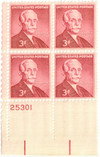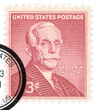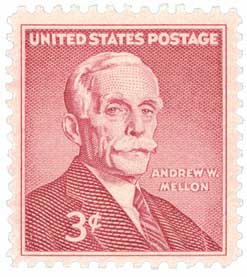
# 1072 - 1955 3¢ Andrew W. Mellon
1955 3¢ Andrew Mellon Issue
City: Washington, D.C.
Quantity: 112,434,000
Printed by: Bureau of Engraving and Printing
Printing Method: Rotary Press
Perforations: 10 ½ x 11
Color: Rose carmine
Birth Of Andrew Mellon
The son of a successful banker and judge, Mellon attended the Western University of Pennsylvania but left before finishing his degree. Mellon’s father recognized his son’s financial abilities at an early age and helped him establish a lumber and coal business. Before long, the younger Mellon made it profitable and he was soon invited to join his father’s banking firm, T. Mellon & Sons.
After just two years, Mellon was placed in charge of the bank and went on to help establish the Union Trust Company and Union Savings Bank of Pittsburgh. He also started getting involved in the whiskey, oil, steel, shipbuilding, and construction businesses. Before long, Mellon was one of the richest people in America.
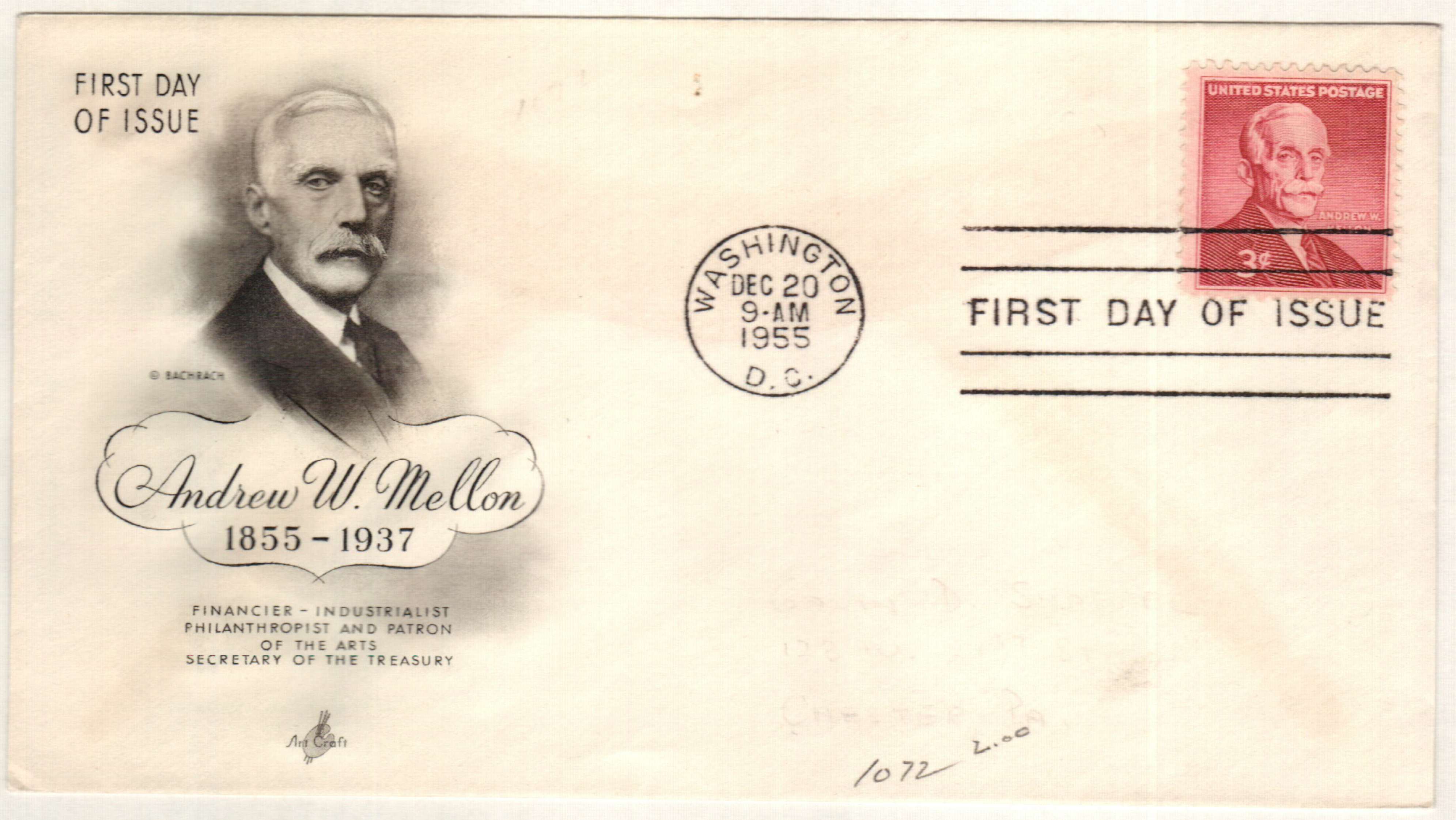
In 1921, President Warren G. Harding appointed Mellon to serve as his Secretary of the Treasury. He called on Mellon to improve the tax system, create a new tariff act, and establish a new federal budget system. Mellon eagerly took on these tasks.
One of Mellon’s largest goals in taking office was to cut down the nation’s debt following World War I. He felt when tax rates were too high, people avoided paying them. So he proposed a four-point plan to cut taxes. His plan included a cut to the top tax rate from 77 to 24 percent, a cut to the low incomes from 4 percent to ½ percent, and a reduction in the federal estate tax. All of this would lead to a more efficient government, as lower tax rates would mean fewer tax returns to be processed by fewer workers as well as less paper and ink used.
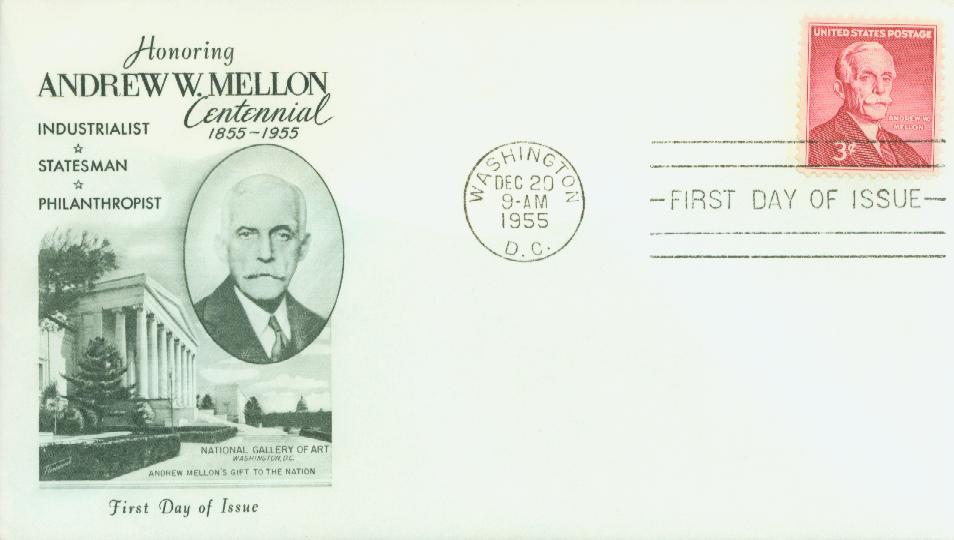
Unemployment fell and tax revenue increased. Historians Schweikart and Allen wrote the economic policies “… produced the most vibrant eight-year burst of manufacturing and innovation in the nation’s history.” Due to Mellon’s policies, the public debt dropped from $33 billion to $16 billion in about 10 years. However, the Depression would see that number rise again.
Though he had made major changes in the years before, Mellon’s popularity waned during the Great Depression. During the Depression, he encouraged the Federal Reserve Board to reduce its discount rate and supported additional rate cuts. He also supported a one percent cut to personal and corporate tax rates and encouraged federal spending on construction projects. Among those projects was Mount Rushmore. Also during this time, Mellon traveled to Europe to negotiate new payment amounts for war debts with France and Germany.
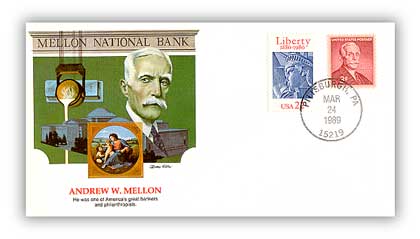
Then in January 1932, articles of impeachment were brought against Mellon. He was accused of holding voting stock in more than 300 corporations while serving in public office. Before the final vote could be held, he accepted an appointment as Ambassador to the Court of St. James and resigned his post. He had served for 10 years and 11 months under three presidents – the third-longest term of a US Secretary of the Treasury.
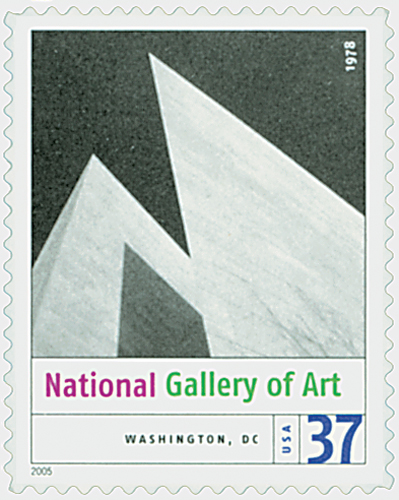
Mellon served in his new position for a year before retiring. He died on August 26, 1937. In addition to his business and political work, Mellon was known for his philanthropy. During his life, he had founded the Mellon Institute of Industrial Research, which later merged with another school to become Carnegie Mellon University. He participated in fundraising for the Red Cross and YMCA and donated a large sum of money to establish the National Gallery of Art.
1955 3¢ Andrew Mellon Issue
City: Washington, D.C.
Quantity: 112,434,000
Printed by: Bureau of Engraving and Printing
Printing Method: Rotary Press
Perforations: 10 ½ x 11
Color: Rose carmine
Birth Of Andrew Mellon
The son of a successful banker and judge, Mellon attended the Western University of Pennsylvania but left before finishing his degree. Mellon’s father recognized his son’s financial abilities at an early age and helped him establish a lumber and coal business. Before long, the younger Mellon made it profitable and he was soon invited to join his father’s banking firm, T. Mellon & Sons.
After just two years, Mellon was placed in charge of the bank and went on to help establish the Union Trust Company and Union Savings Bank of Pittsburgh. He also started getting involved in the whiskey, oil, steel, shipbuilding, and construction businesses. Before long, Mellon was one of the richest people in America.

In 1921, President Warren G. Harding appointed Mellon to serve as his Secretary of the Treasury. He called on Mellon to improve the tax system, create a new tariff act, and establish a new federal budget system. Mellon eagerly took on these tasks.
One of Mellon’s largest goals in taking office was to cut down the nation’s debt following World War I. He felt when tax rates were too high, people avoided paying them. So he proposed a four-point plan to cut taxes. His plan included a cut to the top tax rate from 77 to 24 percent, a cut to the low incomes from 4 percent to ½ percent, and a reduction in the federal estate tax. All of this would lead to a more efficient government, as lower tax rates would mean fewer tax returns to be processed by fewer workers as well as less paper and ink used.

Unemployment fell and tax revenue increased. Historians Schweikart and Allen wrote the economic policies “… produced the most vibrant eight-year burst of manufacturing and innovation in the nation’s history.” Due to Mellon’s policies, the public debt dropped from $33 billion to $16 billion in about 10 years. However, the Depression would see that number rise again.
Though he had made major changes in the years before, Mellon’s popularity waned during the Great Depression. During the Depression, he encouraged the Federal Reserve Board to reduce its discount rate and supported additional rate cuts. He also supported a one percent cut to personal and corporate tax rates and encouraged federal spending on construction projects. Among those projects was Mount Rushmore. Also during this time, Mellon traveled to Europe to negotiate new payment amounts for war debts with France and Germany.

Then in January 1932, articles of impeachment were brought against Mellon. He was accused of holding voting stock in more than 300 corporations while serving in public office. Before the final vote could be held, he accepted an appointment as Ambassador to the Court of St. James and resigned his post. He had served for 10 years and 11 months under three presidents – the third-longest term of a US Secretary of the Treasury.

Mellon served in his new position for a year before retiring. He died on August 26, 1937. In addition to his business and political work, Mellon was known for his philanthropy. During his life, he had founded the Mellon Institute of Industrial Research, which later merged with another school to become Carnegie Mellon University. He participated in fundraising for the Red Cross and YMCA and donated a large sum of money to establish the National Gallery of Art.





